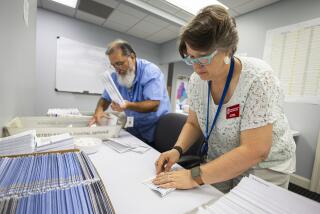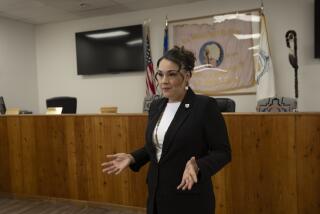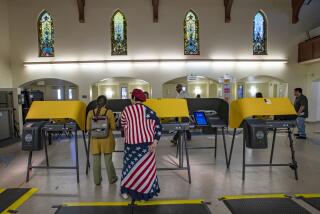Fiasco Reveals a Ballot System Full of Holes
To paraphrase the old saw: If we can put a man on the moon, why can’t we devise a foolproof voting system?
The ongoing fiasco in Palm Beach County, Fla., where about 19,000 potentially crucial presidential ballots were invalidated because of voter confusion and error, makes the question more urgent than ever. This year’s narrow electoral margins also have drawn attention to how low-tech and polymorphous is voting equipment across the nation, where approximately 28 different ballot formats are in use in 192,000 precincts.
The systems in widespread use fall into five main categories, according to a 1998 nationwide survey by Election Data Services, a Washington election consulting firm. These are punch cards, including the antique “Votomatic” system used in Palm Beach (37.4% of all precincts, according to the 1998 survey); hand-counted paper ballots (3%); lever machines, the costly steel behemoths that record a tally when a voter turns a huge metal lever (21.8%); optical scanners, which electronically “read” hand-marked paper ballots (24.7%); and more advanced electronic systems, including touch-screens similar to those used for many bank ATMs (7.3%).
Election experts say none is perfect. “We’ve used every medium short of telepathy to run elections,” says John Seibel, president of True Ballot Inc., which manages elections for labor unions and other organizations. “Every one has its drawbacks.”
Among those drawbacks is the high expense of moving to electronic balloting--although that is a handicap that election officials may be more likely to overlook in light of the Florida snafu.
But there are other issues. The mastodonic lever machines popular in the 1950s and ‘60s are reaching the end of their useful life and are expensive to maintain. Optical scanners, which are the fastest-growing in popularity, require precisely printed ballots and careful marking by voters. And the ATM-style machines provide probably the most accurate counts, but are expensive to buy (costing $3,000 to $10,000 each) and don’t generally provide voting authorities with paper ballots against which to check disputed results.
No Internet Role in the Near Future
As for the one technology popularly viewed as the answer to all ills: Don’t expect the Internet to play much of a role in elections for years, if ever. Experts say the handful of online voting experiments that have been conducted has produced a mixed result.
In March, for example, Arizona allowed online voting in its Democratic primary, in which Vice President Al Gore ran unopposed. Although authorities were encouraged by the high level of participation by 30,000 voters, many ran into glitches that prevented them from casting a vote.
“We’re not ready to do online voting for a national election at this point,” said Lorrie Faith Cranor, an electronic systems expert at AT&T; Laboratories. Among the major problems is that the Web is simply not secure enough for anything as important as a presidential election; the network is vulnerable to an incalculable variety of security assaults that could reflect anything from random vandalism to determined vote-rigging.
In California this year, a task force assembled by the secretary of state to study voting via the Internet concluded that security problems are so great that the very notion should be abandoned for the foreseeable future.
People “are not going to be able to vote from today’s PCs,” said David Jefferson, a member of the task force and a researcher at the Compaq Systems Research Center in Palo Alto. “It makes no difference how strong the encryption is, or whether you use biometric identification, the PC platform does not have strong enough security.”
There also are nontechnical problems. Voting by computer may be more convenient, but it doesn’t guarantee the same privacy as a booth. If workers cast their ballots from office computers, for instance, they could be subject to pressures from their bosses or co-workers.
“After studying Internet voting for the past year and a half, I’ve come to appreciate the polling booth in a whole new way,” said Kim Alexander, president of the California Voter Foundation.
For all that, experts say that of all the formats in use, punch cards are generally the least reliable. Not only do voters have to align their cards perfectly in ballot machines to ensure an accurate vote, the systems’ automatic readers are easily confounded by “hanging chads”--incompletely removed pieces of paper that cover up the punched holes and obscure the vote.
The system in use in Palm Beach County and Los Angeles is so old that the automatic readers are no longer manufactured and are subject to a range of geriatric disorders. During the presidential election of 1996, most of L.A.’s Votomatic counting machines broke down on election day, delaying the final count until after dawn.
Yet Los Angeles retained the system this year for one reason: “It’s cheap,” said County Registrar-Recorder Conny B. McCormack. Replacing the 32-year-old system would cost $100 million, money the county does not have, she said.
Indeed, by far the biggest obstacles to wholesale upgrading of the national balloting technology are cost and inertia. For most local officials, the existing patchwork is adequate to serve through the average election day and is swiftly forgotten thereafter. Indeed, in almost every other presidential election of the last 100 years, confusion on the scale of Florida’s would barely register as a blip in the national count.
Election Offices ‘Last in Line’ for Funding
“We have a saying here that no one ever wakes up and says, ‘What a beautiful day, I think I’ll buy me a new voting system,’ ” said Larry Ensminger, a sales executive for Global Election Systems, which markets optical scanners and touch-screen units.
That is especially true in light of their cost. “Most county election offices are last in line when the county supervisors hand out the funds,” said Kimball Brace, president of Election Data Services. “Their attitude is: ‘You people work two days a week, why are you here looking for money?’ ”
Still, some localities that have bitten the financial bullet and purchased new systems are pleased with the result. Among them is Riverside County, which rolled out 4,200 touch-screen voting machines in its 715 polling places Tuesday. The system, which will cost $13 million over 15 years but is expected to save as much or more in annual printing and personnel expenses, won raves from voters and county officials alike.
Voters simply pressed on-screen “buttons” to record their choices; the machines, which unfold from plastic suitcases into standing polling booths, complete with computer screen, privacy hood and table legs, were programmed to reject any attempt to vote for, say, two candidates for president--one of the problems that bedeviled the vote in Florida.
“It’s extremely easy, like getting gas at the gas station,” said Sue Martine, staff analyst at the county registrar’s office.
Merchants of voting systems hope that this year’s snafu will encourage local officials elsewhere to reevaluate their antiquated systems. “Obviously it has crossed our mind that this provides an opportunity for us,” said Ensminger, the Global Elections sales executive.
Or, as Brace put it: “Nobody wants to be the next Palm Beach.”
*
Times staff writer Jeff Rabin contributed to this story.
(BEGIN TEXT OF INFOBOX / INFOGRAPHIC)
How America Votes
Voters nationwide may see more electronic voting machines and fewer written or punched ballots as a result of the voting fiasco in Florida. Here are the five main voting methods and a breakdown of who used them in the 1998 elections:
*
Punch cards: 37.4%
Voters punch holes in card next to their choices. Cards are counted by machine or computer. Method first adopted in 1964.
*
Pencil-shaded computer cards: 24.7%
Voters shade in area next to their selections. Darkest marks are read by a computer. Also used in standardized testing and lottery. Referred to as “Marksense” optical scan.
*
Mechanical lever machines: 21.8%
Voters pull a lever to open and close curtain enclosing the booth. Voters choose from an array of levers on a machine, corresponding to candidates and issues. First used in 1892.
*
Direct recording electronic system: 7.3%
Voters use a touch-screen or keyboard to make their choices. Votes are recorded electronically and stored in computer.
*
Paper ballots: 3%
Voters mark squares next to their selections and drop ballot into a sealed box. Mostly used in small communities and rural areas.
*
How Florida Votes
By number of counties
Scanners: 38
Punch card: 26
Mechanical: 2
Paper ballot: 1
Source: Election Data Services, AP
Researched by JULIE SHEER / Los Angeles Times
More to Read
Get the L.A. Times Politics newsletter
Deeply reported insights into legislation, politics and policy from Sacramento, Washington and beyond. In your inbox three times per week.
You may occasionally receive promotional content from the Los Angeles Times.










